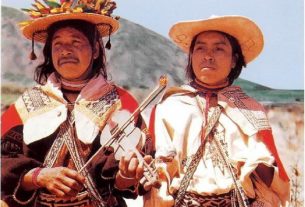Mexican Kitchen
Although many of the recipes I try come from friends, market salespeople, food stand cooks and restaurant chefs in many parts of Mexico, there is nothing like a good cookbook for inspiration, especially when it comes to putting together different courses to create a harmonious meal. To me, the very best of Mexican cooking is both regional and artisanal, and these are the qualities I look for in cookbook recipes.
Many of today’s culinary writers cater to the armchair traveler as well as the home cook, producing books that give the reader an insight into indigenous ingredients and their origins as well as gastronomic history and traditions. Whether focusing on one particular region or presenting an overview of several, the very best of these writers present us with a cultural connection to the food we choose to prepare.
Keeping all this in mind, I have put together a collection of Mexican cookbooks that I can count on not only for dependable recipes and clear instructions, but for good reading and information about the region and its people. In short, I prefer the kind of cookbook I can curl up with and be transported to the Sierra Mixteca of Oaxaca, the Caribbean coast of the Yucatan, or any number of places throughout Mexico, and be motivated try their special dishes in my own home.
However, not all of my cookbooks fall into the category of “gourmet travel.” Some are the very simple, straightforward recipe collections that became popular in Mexico in the 1930’s, through the efforts of the pioneering cookbook writer and teacher Josefina Velazquez de Leon. (Many of her collections are still in print, and a dinner recreating some of her recipes was held this year at Alicia Gironella De’Angeli’s El Tajin restaurant in Mexico City.) This type of recipe collection continues to be popular here in Mexico, and I have bought many inexpensive, soft-cover collections at the local book fairs held at makeshift outdoor stalls. Some of these are so inexpensive that even a single good recipe is worth the purchase price. Thus, my cookbook shelves contain an eclectic mix, from glossy, superbly photographed coffee table books to humble bookstall pamphlets.
The following list, while necessarily personal, is made up of books that I have used and recommend. I have successfully tried recipes from all of them and they are the first ones I reach for when in need of ideas for a meal or a refresher on ingredients and techniques for a certain dish. Any one of these would make a great holiday gift for the novice or experienced Mexican cook, and they are, of course, “a gift that keeps on giving.” They are not listed in order of preference, but rather in the alphabetical order of the author’s last name.
Mexico: One Plate at a Time by Rick Bayless with Jeanmarie Brownson and Deanna Groen Bayless, photos by James Isberner (Scribner, 2000)
The recipes in this book are consistently good, and many are updated versions of classics. Adding roasted poblano chiles to guacamole, for example, works well and is a nice change. The recipes go into great detail, and for novice Mexican cooks this will be a plus because it is an excellent way of learning how Mexican dishes are put together. People following these recipes outside of Mexico will appreciate the substitute ingredient suggestions, and everyone will enjoy the location photos taken in different regions of the country.
La Tradicional Cocina Mexicana y sus Mejores Recetas by Adela Fernandez (Panorama Mexico, 1998.)
Maybe I like this book because I learned so much “kitchen Spanish” by reading it, and though I still use my old copy, readers interested in a tasty way to improve their Spanish will be happy to know that it is now available in a bilingual edition, with the Spanish and English on facing pages. Fernandez is the daughter of the late Mexican film director Emilio ( “El Indio”) Fernandez, and her descriptions of the meals he served his famous guests during the Golden Age of Mexican filmmaking are delightful to read. Her history of Mexican food is a good, compact introduction to this topic, especially the section on pre-Hispanic foods. These are very traditional recipes from all parts of the country, the kind like grandma used to make, whether she was from Chihuahua, Chiapas or somewhere in between.
The Essential Cuisines of Mexico by Diana Kennedy (Clarkson Potter, 2000.)
This combines Kennedy’s first three books, The Cuisines of Mexico, The Tortilla Book and Mexican Regional Cooking, making it indispensable to any Mexican cookbook collection. Since the author started writing cookbooks thirty years ago, much has changed, including the availability of Mexican ingredients north of the border, and this volume reflects these changes. With over 300 recipes from different regions, the book provides endless meal ideas and very entertaining reading. I especially enjoy her vignettes describing different experiences cooking with, and learning from, a large cast of characters.
Cuisines of Hidden Mexico: A Culinary Journey to Guerrero and Michoacan by Bruce Kraig and Dudley Nieto (John Wiley and Sons, 1995.)
This is one of those culinary travel books that capture my attention every time. The authors describe their trip through the western Mexican states of Guerrero and Michoacan as part of a PBS film crew and on the way, became entranced by the food of the region. Because it keeps to one specific area of the country, the book provides an in-depth look at that area, its people and cuisine. The reader learns a great deal about the origins of the ingredients, their selection and preparation, as well as getting very authentic recipes. It seems to me that this book would be a “must” for readers whose families came from Guerrero or Michoacan, and who may remember some of the dishes and customs their grandparents talked about.
Zarela’s Veracruz by Zarela Martinez (Houghton Mifflin, 2001.)
Zarela Martinez, New York restaurateur and author, has written other Mexican cookbooks, including one in which she describes the ranch food of her childhood in northern Mexico, but this book, to me, is her best by far. Possibly because I love Veracruz, its food and its people, I was delighted to read a book by someone who evidently feels exactly the same way. The author has done a really excellent job of defining the different regions-within-a-region that make up the state of Veracruz, and not only provides excellent recipes (the ones involving fruit liqueurs, such as a chicken in orange sauce that my husband flipped over, are particularly wonderful) but excellent restaurant tips as well. Although we had been to different parts of Veracruz many times before, we brought this book along and ate our way from one to another of the restaurants mentioned. I highly recommend readers doing the same.
Mexico: The Beautiful Cookbook by Susana Plazuelos with Marilyn Tausend, photos by Ignacio Urquiza (Harper Collins, 1991, paperback Harper Perennial Library, 1999.)
Just about every culinary region of Mexico is represented in this book, which is interesting to read, with Marilyn Tausend’s text providing historical and cultural background, and to look at, thanks to Ignacio Urquiza, who is considered to be one of the best food photographers anywhere. The author, a chef and caterer, has a knack for combining disparate ingredients and comes up with some enticing nueva cocina recipes as well as more traditional dishes. This book has given me lots of ideas for dinner parties, and its mix of modern and traditional recipes makes it a good book for a basic collection.
The Taste of Mexico by Patricia Quintana, photos by Ignacio Urquiza (Stewart, Tabori and Chang, 1993.)
Mexico City celebrity chef, restaurateur and prolific cookbook author Patricia Quintana is one of those gastronomic experts whose recipes, in my experience, never seem to fail. Although she has written several dependably good cookbooks, this one, a region-by-region guide to Mexican food, belongs on the shelf of anyone interested in cooking or eating Mexican food. It divides the country into distinct culinary regions, starting with a map, and gives information on the characteristic ingredients, dishes and culinary customs of each region. This is one of those books I turn to again and again, and I highly recommend it not only for the excellent recipes but also for a good, solid overview of Mexico’s culinary landscape.
Savoring Mexico: Recipes and Reflections on Mexican Cooking by Marilyn Tausend, Ignacio Urquiza, photos by Noel Barnhurst (Leisure Arts, 2002.)
This is a beautiful and worthwhile book, full of authentic recipes that come right from the source. Because the author travels in Mexico so frequently, leading culinary tours, she is in contact with the best restaurant chefs and home cooks in the country, and the book reflects this intimate knowledge. When I first picked up the book, I immediately found several dishes that I had eaten before and enjoy cooking at home. Torta azteca, for example, is a typical central Mexican home cooked specialty, and the author’s version is every bit as authentic as that taught to me by a cook in Cholula, Puebla. The photos that accompany the recipes are a real plus and serve as further inspiration to prepare this food and dig in.
Seasons of My Heart by Susana Trilling (Ballantine, 1999.) Subtitled “A Culinary Journey Through Oaxaca, Mexico.”
This book, a companion to the author’s PBS television series of the same name, is both a work of culinary anthropology and a warm, loving tribute to the region where Trilling makes her home and runs a cooking school. One of the characteristics that make Oaxaca so unique is the geography that divides it into several regions within the same state, and each of these areas has its own distinct cuisine. The reader travels with the author as she visits homes, restaurants, markets, mountain villages, coffee plantations, beachfront seafood shacks, bakeries, cheesemakers and an assortment of indigenous cooks in each of the seven regions of Oaxaca. From a wedding in the jungle outside Tuxtepec to an elegant New Year’s dinner in Oaxaca city, Susana Trilling seems right at home and always gives credit to the hosts who shared their recipes. Many of these recipes, being very authentically oaxaqueño, are heavy on the chile, so starting out with half the amounts given may be a good idea. Because many people of this region do not eat a lot of meat, the book is particularly recommended for vegetarians and seafood lovers.
A Cook’s Tour of Mexico: Authentic Recipes from the Country’s Best Open-Air Markets, City Fondas and Home Kitchens by Nancy Zaslavsky (St. Martin’s Press, 1997.)
Being an uncontrollable market addict, this is the kind of book I can really sink my teeth into. Very well organized by region, it provides a guide to several markets, including tips on which stalls are good for certain foods, and of course gives the recipes from the cooks themselves. The fact that this is also a culinary guidebook in no way detracts from its value as a cookbook, as evidenced by its nomination for the James Beard award. Travelers to Mexico, as well as stay-at-home foodies, will be rewarded with mouth-watering reading while taking this “cook’s tour.”


